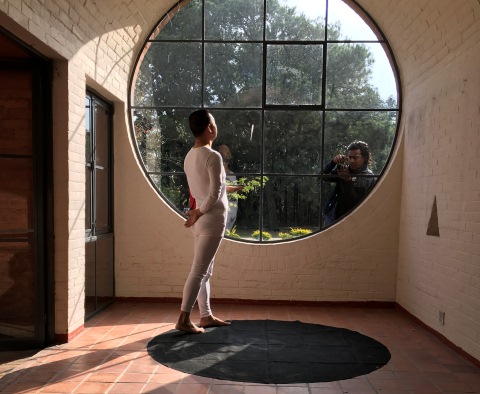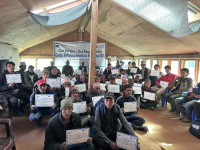Culture & Lifestyle
An intriguing, confusing art festival
There's much to make meaning out of at the Kathmandu International Performance Art Festival 2019, yet the festival falls short of making the art powerful..jpg&w=900&height=601)
Srizu Bajracharya
There’s a deafening, awkward silence as Bingqiang Yin, a performance artist from China, starts making graceful rounds inside a black canvas cloth—his stage—at one of the halls of the Taragaon Museum. The round black canvas has five concentric circles while its back is white in colour. Yin too is dressed in a white t-shirt and tight black pants. He walks around the first ring of the circle and then sits down to cut the sphere out.
As his scissors touch the crispness of the canvas, the distinct sound of the sharp cutting pierces the silence. Yin then puts on the ring that he has cut and repeats the same drill until he finishes cutting all the circles. While he does, he moves his body into different postures, stands with crossed feet, his two hands reaching out to the sunlight outside the window. Towards the end, he sticks himself to the round window of the museum. It seems as though Yin is trying to show us how he is suffocating inside and wants to be part of the freedom that he sees from inside an empty room.
However, the deafening silence that filled the room, full of more than a dozen people, was not just because Yin’s performance was intriguing, but because people were trying hard to understand his actions. Yin’s performance is part of the Kathmandu International Performance Art Festival 2019, organised by Bindu, space for artists at The Taragaon Museum—the second iteration of the performing arts festival in Kathmandu with its first in 2016.
When Yin’s performance ended, the audience looked at each other with puzzled faces. One person from the audience even called out to the organisers asking for a title to make sense of the performance. And this is the overview of the entire festival—the audience throughout the performances are left to think hard. It was only later that I found out that Yin was actually trying to explain about being with nature, and the suffocation one feels when one is locked inside a room.
The show put up on the second day at the Kathmandu International Performance Art Festival is powerful and compelling, yet confusing and exhausting; exhausting because throughout the performances, audiences are trying to make meaning of the performing arts of the artists.
And yet, the small crowd graciously takes time to understand the devotion of the artists. The Kathmandu International Performance Art Festival 2019 brings together 14 performing artists from six countries to discuss climate change, environmental destruction, living with nature and mental health along with familial relationships.
One of the most exceptional performances at the festival was from Dhruba Raj Sharma, whose work centred on the theme to educate people about human consumption of meat. At the amphitheatre of the Taragaon museum, Sharma had a bell around his neck, crouched on his knees to rub raw meat on his bare skin. Once done, he approached the audience with turmeric paste, asking them to rub it against his skin. He also gave a handful of raw meat to some front- and second row-audience members. While some viewers refused, some reluctantly and awkwardly participated in his act, holding on to the bloody meat. One could also see how uncomfortable some of the audience was with the sudden attention of the crowd.
“I have titled my act as ‘Badhshala’ (Abattoir). I feel as humans, we should voice for the animals who can’t speak for themselves. I wanted to make the audience think about the meat they consume,” said Dhruba Raj Sharma, the performance artist.
While Sharma’s performance bewildered the audience, another artist Kunti Thapa Magar rendered goosebumps on the spectators. Her performance titled, ‘The Meeting Point’ saw her caressing a plant in an earthen pot. Throughout her act, she would place the plant around her body, as though telling the audience about the intimate relationship of humans with the greenery they live with. The performance was horrific and tear-jerking, especially when Magar started eating the raw plant destructively. Some from the audience seemed worried whether the plant was even edible.
In performing arts, artists use their bodies as a medium of artistic expression to discuss social issues. These performances are done in front of a live audience so as to persuade viewers to take action on the issues being performed. The history of this artform goes back to 6th century Greece, where poets like Sophocles performed their poetry with gestures. But in Nepal, performing arts is still relatively new and is considered as a modern-day interactive compact art form.

Many in Kathmandu have been acquainted with this art form through Ashmina Ranjit, who has over the years enacted many performing arts that discuss politics of gender, sexuality and desires. And the art form through the years has proven to be very influential and provocative. In 2016, a group of Nepali artists, to support Doctor Govinda KC’s hunger strike against corruption, had taken to the road bare-foot with their eyes closed, enacting a performance art action, which helped discuss corruption in Nepal. And gradually, this art form has been taking the interest of people. And this shows in the Kathmandu International Performance Art Festival 2019, where the dedication of the artists and the patience of the audience tells why the artform is intriguing and powerful.
“Performance art is powerful because it is provocative and interactive, as the connection with the audience is more intense because people themselves perform the art to talk about a cause. The human connection makes the art more persuasive than 2D paintings,” says Prithvi Shrestha, founder of Bindu, space for artists and a painter himself.
Kathmandu International Performance Art Festival demands people’s attention and is powerfully resonant with the issues happening around the world. However, the crowd that saw the event was still very small in number compared to other art festivals that happen around Kathmandu.
Perhaps the festival should have chosen a public space rather than an open museum away from the core of Kathmandu. For what is the point of performing arts inside a closed environment, if it can’t tickle the minds of the masses who are part of the problem?
Besides the performances, the festival fell short of being great, as it seemed hasty and informal with no proper host. The festival felt like it was running out of time. But no one had a clear idea of the timings of the performance and how much each artist would get time to speak about their performance. And with the quick change of venues inside the compound of the Taragaon museum, it felt even more perplexing to understand what the difference in the environment meant for the various performances. The artists might have shared their ideas about their performance for the festival the day before, at the Artist Talk programme at Tara Art Gallery.
However, the same iteration would have made this performance art festival even more powerful.
The festival certainly would have been more engaging if the audience had a context to build meaning upon; however, that is what makes it more compelling, says Prithvi Shrestha.
The festival closes tomorrow with a set of performing artists performing at Panauti from 2 pm.




 9.12°C Kathmandu
9.12°C Kathmandu















